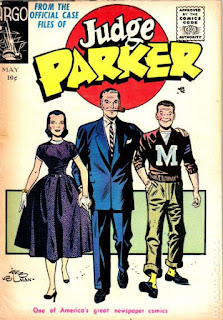Bill Knight column for Thursday, Friday or Saturday, Feb. 2, 3 or 4
Federal Judge Amos Mazzant’s December ruling blocking President Obama's attempt to expand overtime pay protections to millions of Americans was a post-election reminder of the significance of the judicial branch, from District Courts to the U.S. Supreme Court. That was clarified last weekend when Judges in Virginia, New York and elsewhere blocked some of President Trump’s executive order affecting travelers – and lawful residents – who originate from seven Muslim-majority nations. And at press time, it was expected that Trump was poised to nominate a Justice to fill the vacancy of the late Antonin Scalia.
Given Trump’s first 10 days in office, would anything be surprising? He could nominate his sister, Judge Maryanne Trump Barry of the U.S. Court of Appeals for the Third Circuit. He could nominate TV’s Judge Judy, or the funnies’ Judge Parker (who might be “unbelievably highly respected,” as Trump teased, but leaning toward the unbelievable since he lives only on newspapers’ comics pages).
Since the death a year ago of Scalia, a Reagan appointee, the Supreme Court is split into four mostly liberal and four mostly conservative voices, and three could retire. Stephen Breyer is 78, Ruth Bader Ginsburg is 83, and Anthony Kennedy is 80.
That’s more relevant because key issues of public concern are “settled” but could be revived through related cases:
Affirmative Action: “Fisher v. University of Texas” (2016); Campaign finance: “Citizens United v. F.E.C.” (2010); Class-action suits: “Wal-Mart v. Dukes” (2011); Climate change: “West Virginia v. EPA” (2016); Handgun restrictions: “District of Columbia v. Heller” (2008); Immigration reform: “U.S. v. Texas” (2016); Labor unions: “Freidrichs v. California Teachers Association” (2016); Redistricting: “Arizona v. Arizona Independent Redistricting Commission” (2015); Same-sex marriage: “Obergefell v. Hodges” (2015); Voter-ID laws: “Shelby County v. Holder” (2013); Women’s contraception: “Burwell v. Hobby Lobby (2014).
Apart from specific issues and past cases, the Court’s makeup can have a chilling effect on litigation. For example, in 2013 the Graphic Communications sector of the Teamsters union, following a six-year battle over Santa Barbara News-Press journalists fired after joining the union, decided to drop the case after losing in federal court – because the U.S. Supreme Court seems hostile to labor and an adverse ruling there could set a dangerous precedent making organizing difficult for all U.S. workers.
For months, Trump has listed 21 names as his possible nominees, people suggested by the arch-conservative Federalist Society, which embraces the idea of an “originalist” interpretation of laws, a perspective that the Constitution means exactly what the Founders intended in the 18th century, when single-shot muskets were used, women couldn’t vote, and black people were property.
“The people he has said he will choose from are straight out of conservative central casting,” said Richard Wolf in USA Today. “They are overwhelmingly white, male and middle-aged.”
Two fervent voting-rights opponents are on Trump’s list: William Pryor of the U.S. Court of Appeals for the 11th Circuit in Atlanta, and Robert Young, Chief Justice of the Michigan Supreme Court.
“Taken together, the records of these potential Trump nominees reflect a radical-right ideology that threatens fundamental rights, and that favors the powerful over everyone else – especially people from historically marginalized communities,” said Nan Aron, president of the Alliance for Justice Action Campaign.
Frontrunners for Trump’s favor are Pryor, Thomas Hardiman of the 3rd Circuit in Philadelphia, and Neil Gorsuch of the 10th Circuit in Denver. Pryor (a protégé of controversial Attorney General nominee Jeff Sessions) also opposes women’s choice, gay rights and gun regulations. Hardiman is a staunch conservative and serves with Trump’s sister. Gorsuch is another originalist and has deferred to faith groups objecting to the Affordable Care Act.
“As Democrats and the labor movement prepare for a possible fight over Trump’s imminent appointment to the Supreme Court, they should recognize that several major labor cases, brought by some of labor’s most persistent enemies, are waiting in the wings,” said attorney Moshe Z. Marvit, co-author (with Richard Kahlenberg) of “Why Labor Organizing Should be a Civil Right.”
“Senators should question nominees about … Supreme Court precedents that protect public employees’ labor rights,” he said. “And if labor has any sway within the Democratic Party, it should make it clear that these issues should be disqualifying for any new appointment to the Court.”
Confirmation of any nominee will require eight Democrats in the current Senate. Will they resist a Judge Juggernaut? Will Republicans try to change Senate's rules to eliminate the 60-vote threshold needed to bring the nomination to the floor (which Trump endorsed last week)?
Maybe THIS is bad TV, or the funny papers?
[PICTURED: Cover of a 1956 comic book compilation of newspapers' Judge Parker comic strip.]


No comments:
Post a Comment
Note: Only a member of this blog may post a comment.